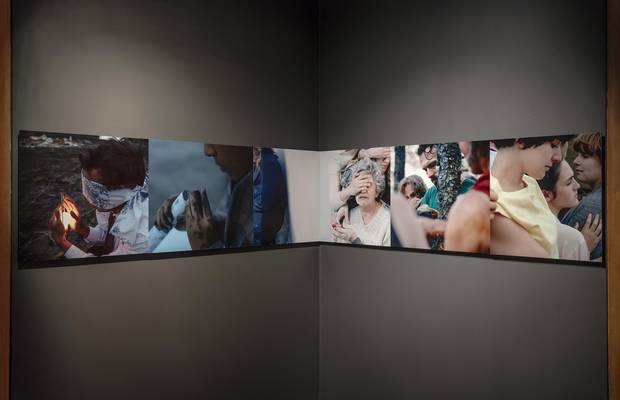Canada doesn't produce art stars. Or so goes the common grouse.
Visiting the Sobey Art Award exhibition at University of Toronto's Art Museum, however, you'll find only bright and boisterous artistic voices. Stars that ought to be – the five finalists, all under 40 years old, who are vying for the country's richest prize in contemporary art.
"The breadth of media on view is remarkable," says exhibition curator Sarah Robayo Sheridan. "From what look like Xerox prints to crushed cars and wildlife fencing. The work possesses a lot of ambition."
It isn't a thematic show, she explains. The only criterion was excellence, but a common inquiry emerges – "a timely and critical question," she calls it – that all of the artists variously ask: What are the stakes of living together?
A gold-painted 1987 Jaguar Vanden Plas crushed and twisted at the cabin calls visitors into the front room. In 2010, Winnipeg-based artist Divya Mehra presented the car – then unscathed – as a wall piece reflecting on the "American Dream." It was an emblem of aspiration. She thought of it as a trophy. Seven years on, the dream has been badly damaged, squeezed by the daily violence of racism, she says, so she had the car worked over by a scrapyard crane.
Divya Mehra’s crushed 1987 Jaguar Vanden Plas represents the damaged American Dream.
Georgia Scherman Projects
The sculpture appears alongside a shoulder-high stack of patio stones salvaged from her parent's first restaurant when it was forced to move, and the ornamented, brass pedestal from a seven-foot Ganesh statue stolen from outside their Ottawa establishment. "I wanted to create things that were less like monuments," Mehra says, "and more like ruins."
Representing Quebec, Jacynthe Carrier offers two films and a photographic series, picturing an imaginary community at work on some mystery custom. Cutting twine and grinding stones, their activities appear arcane to an outsider, but they move quietly and instinctively together through the tasks.

Jacynthe Carrier’s La Ligne.
Galerie Antoine Ertaskiran
In the next room stands an eight-foot-tall, 400-square-foot pen made of lumber and wire fencing. At one end, there's an ungulate gate – the kind of one-way barrier used to control wildlife movement. The gallery walls are covered in the dense, repeating image of an abstracted balsam tree, mottled with lichen and chewed up by moose. An LED lighting program simulates sunrise, high noon, and sunset, cycling over every 40 minutes. Dartmouth-based, multidisciplinary Mi'kmaq artist Ursula Johnson here considers how the project of colonization reshapes both people and nature.
Ursula Johnson’s Moose Fence.
Handout
The representative for Ontario, Bridget Moser, presents two new videos, shot this past summer, as well as a performance piece. Via monologue, the Toronto-based artist leads an absurdist investigation of self, using and misusing the items of her prop chest to consider her own function. Her personal anxieties pile, sketching a more ambient, cultural sense of worry attached to the era of the video diary and the status update.
Bridget Moser’s Every Room is a Waiting Room, Part 1.
Toni Hafkenscheid
Opposite that and just off Johnson's gallery, Vancouver-based artist Raymond Boisjoly, of Haida and Québécois heritage, has hung a single word. "Discordancy" is stretched across the long gallery wall and exploded in tiled tangerine- and magenta-coloured eight-by-10 pages. Visitors must walk around the exhibition space to decipher the message. There is no perfect or complete vantage point. "Text is often used to communicate with immediacy within art," Boisjoly says, "so I'm thinking about what it means to slow that process or to produce an alienating reading experience."
Visitors have to walk around the space to decipher the message in Raymond Boisjoly’s tiled piece.
Catriona Jeffries
As an Indigenous person making text-based art in English, Boisjoly is interested in how colonial histories impact his thinking about the possibilities for art. "The English language being imposed," he says, "and how it structures our thought." Accordingly, he's envisioned a reading exercise that is obscured and conflicted and born of tension. He's written a word that tries not to be read.
The $50,000 winner of the Sobey Art Award will be announced during a gala at the Art Museum at the University of Toronto Oct. 25.